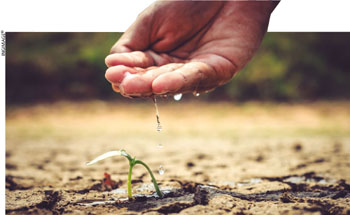WATER SECURITY
THE TAPS ARE RUNNING DRY
Sashan Rodrigo elaborates on how mismanagement leads to critical shortages

From the Murray-Darling basin in Australia, to Cape Town in South Africa and Chennai in India, there are reports of water scarcities around the world. Meanwhile, we in Sri Lanka may enjoy this vital resource and feel secure due to a perceived abundance of water.
However, it would be foolish to ignore the warnings of others because an abundance of resources does not necessarily imply security.
CAPE TOWN Over the past three years, multiple instances of water shortages have been reported by the global community. In Cape Town for example, the term ‘day zero’ was used to describe an event where the city would run out of water on a specified day.
While many would point to the drought that affected its water supply reservoirs, which hadn’t experienced steady rainfall since 2015, inactivity on the part of the South African government exacerbated the shortage. And this led to an already water stressed region having to face a severe scarcity of water.
The Government of South Africa did not declare a national disaster until mid-February 2018 – although 2015, 2016 and 2017 were severe drought years. In addition, its Department of Water and Sanitation had not budgeted for a drought in financial year 2017/18, which meant that emergency funds could not be allocated to the water scarce region.
Add to this political infighting, and Cape Town was left with a dry throat and no relief, which could have been avoided or mitigated had the relevant authorities acted on information received back in 2015.
MURRAY-DARLING SYSTEM In Australia, the Murray-Darling basin, which comprises a system of approximately 100 waterways, has faced water shortages due to heavy irrigation and household use. Water levels in rivers have depleted to about a third of their historical flow as a result of this.
Its riverine systems downstream do not have adequate water to flush out contaminants, which result in algal blooms and ecological problems with marine life. Yet, nothing was done until last year when the Government of South Australia commissioned a report that made recommendations to solve water related issues.
The issue of mismanagement in this case comes in the form of a disconnect between the Water Act No. 137 of 2007 and Basin Plan 2012.
It appears that the carrying capacity of the river system (i.e. how much water is removed compared to how much is replenished), the impacts of climate change, and coordinated decision making between the states along the system and the federal government – among other factors – were not taken into account in the original Basin Plan 2012.
This resulted in a severely mismanaged water system that could have been avoided if proper policies had been implemented earlier.
INDIAN SUBCONTINENT India is facing one of its worst water crises on record. Last year, government data indicated that a majority of its reservoirs were operating below nominal capacity and others were running at the lowest capacity in a generation.
Competition between agriculture, industry and individuals means that 54 percent of India’s landmass is under extreme water stress, and approximately 70 percent of the local population receives as little as three hours of running water a day.
The scarcity of water is lead-ing to higher rates of suicide by farmers and lower quality levels of water extraction – and this leads to waterborne diseases, which affect public health.
In this instance, water mismanagement stems from an institutional failure to recognise that crops such as sugarcane – which the government has subsidised – are water intensive. Additionally, heavily subsidised water resources have led to poor policies, which creates a wasteful culture of usage.
Trans-boundary issues between India, Bangladesh and Pakistan also serve as a chokepoint when it comes to water mismanagement. If these countries do not cooperate on shared and efficient water distribution, the subcontinent could continue to fall short of meeting its water demands.
SRI LANKAN STORY What do these three examples mean for Sri Lanka? Although the island doesn’t have to worry about trans-boundary issues, it does need to be cognisant of poor water management.
For instance, to counter power shortages, Sri Lanka approved four more coal power plants (which are known to be severely water intensive) in June. A recent report by Greenpeace states that coal power plants consume sufficient water over their lifetime to sustain more than a billion people.
There are multiple reports of water contamination that can be attributed to overuse of fertiliser. Additionally, citizens may be polluting waterways with plastic and other waste – so it goes without saying that Sri Lanka has a lot to work on to preserve its water resources.
Successful implementation of an integrated water resource management system would go a long way to prevent water scarcity in Sri Lanka and help mitigate the effects of climate change on its water resources.




